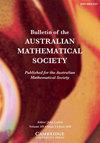ASYMPTOTIC BEHAVIOUR FOR PRODUCTS OF CONSECUTIVE PARTIAL QUOTIENTS IN CONTINUED FRACTIONS
IF 0.5
4区 数学
Q3 MATHEMATICS
引用次数: 0
Abstract
Let  $[a_1(x),a_2(x),a_3(x),\ldots ]$ be the continued fraction expansion of an irrational number
$[a_1(x),a_2(x),a_3(x),\ldots ]$ be the continued fraction expansion of an irrational number  $x\in [0,1)$. We are concerned with the asymptotic behaviour of the product of consecutive partial quotients of x. We prove that, for Lebesgue almost all
$x\in [0,1)$. We are concerned with the asymptotic behaviour of the product of consecutive partial quotients of x. We prove that, for Lebesgue almost all  $x\in [0,1)$,
$x\in [0,1)$,  $$ \begin{align*} \liminf_{n \to \infty} \frac{\log (a_n(x)a_{n+1}(x))}{\log n} = 0\quad \text{and}\quad \limsup_{n \to \infty} \frac{\log (a_n(x)a_{n+1}(x))}{\log n}=1. \end{align*} $$
$$ \begin{align*} \liminf_{n \to \infty} \frac{\log (a_n(x)a_{n+1}(x))}{\log n} = 0\quad \text{and}\quad \limsup_{n \to \infty} \frac{\log (a_n(x)a_{n+1}(x))}{\log n}=1. \end{align*} $$
We also study the Baire category and the Hausdorff dimension of the set of points for which the above liminf and limsup have other different values and similarly analyse the weighted product of consecutive partial quotients.
连续部分商乘积在连续分数中的渐近行为
让 $[a_1(x),a_2(x),a_3(x),\ldots ]$ 是无理数 $x\in [0,1)$ 的连续分数展开。我们关注的是 x 的连续部分商乘积的渐近行为。我们证明,对于 Lebesgue 几乎所有的 $x\in [0,1)$, $$ (begin{align*})。\liminf_{n\to\infty}\{log (a_n(x)a_{n+1}(x))}{log n} = 0(四边形){text{and}(四边形) \limsup_{n \to\infty}\frac{log (a_n(x)a_{n+1}(x))}{log n}=1.\end{align*}$$We also study the Baire category and the Hausdorff dimension of the set of points for which the above liminf and limsup have other different values and similarly analyse the weighted product of consecutive partial quotients.
本文章由计算机程序翻译,如有差异,请以英文原文为准。
求助全文
约1分钟内获得全文
求助全文
来源期刊
CiteScore
1.20
自引率
14.30%
发文量
149
审稿时长
4-8 weeks
期刊介绍:
Bulletin of the Australian Mathematical Society aims at quick publication of original research in all branches of mathematics. Papers are accepted only after peer review but editorial decisions on acceptance or otherwise are taken quickly, normally within a month of receipt of the paper. The Bulletin concentrates on presenting new and interesting results in a clear and attractive way.
Published Bi-monthly
Published for the Australian Mathematical Society

 求助内容:
求助内容: 应助结果提醒方式:
应助结果提醒方式:


